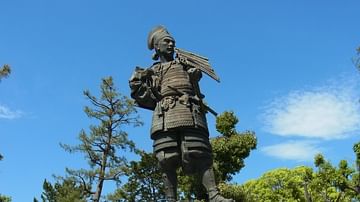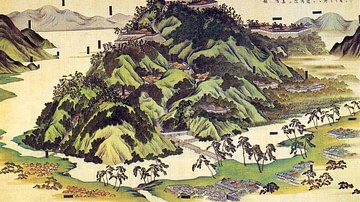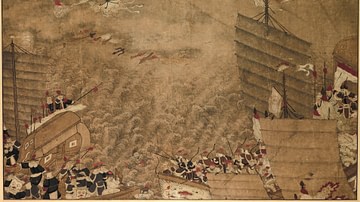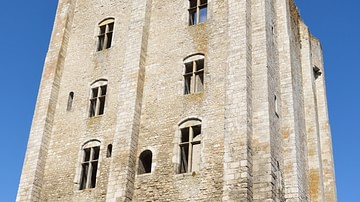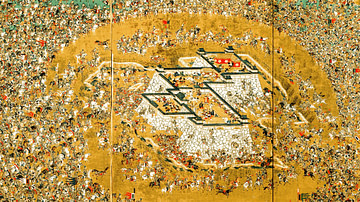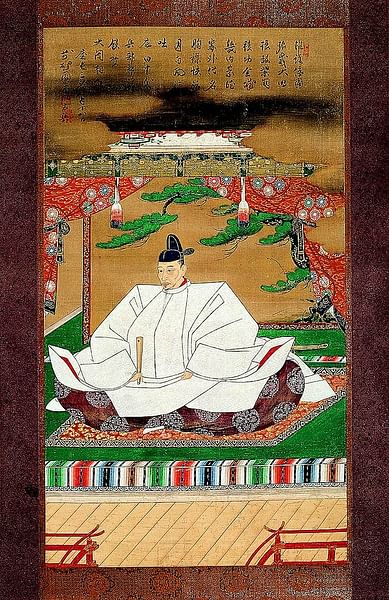
Toyotomi Hideyoshi (1537-1598 CE) was a Japanese military leader who, along with his predecessor Oda Nobunaga (1534-1582 CE) and his successor Tokugawa Ieyasu (1543-1616 CE), is credited with unifying Japan in the 16th century CE. Hideyoshi rose from a humble background to become the country's military supremo, and he then reorganised the class system, instigated tax reforms, built castles, restored temples, and launched two invasions of Korea. Hideyoshi's foreign ambitions may have met with disaster but his restructuring of the state would establish the social and political norms which endured in Japan until the 19th century CE.
Nobunaga & Taking Power
Hideyoshi, originally named Kinoshita Hiyoshimaru, was born into a peasant family in 1537 CE. As a young man, he joined the army of the military leader/warlord Oda Nobunaga and rose through the ranks to eventually become a general and the most important military commander in Nobunaga's endeavour to conquer rival feudal lords and so unify Japan. Hideyoshi might have gained his overlord's respect as a commander but his small physique resulted in Nobunaga giving him the unflattering nickname of Saru or 'monkey.'
In 1582 CE Nobunaga was betrayed by one of his vassals, Akechi Mitsuhide, and obliged to commit suicide to avoid being handed over to his rivals. Hideyoshi, first killing Mitsuhide, then manoeuvred to gain the support of Nobunaga's relations and other important daimyo or feudal lords. He was thus able to install himself as the new military supremo in Japan, as yet, still only half of which was unified.
Hideyoshi, now commanding a force of some 200,000 men, successfully combined military campaigns with diplomacy amongst his rival daimyo to establish himself as the ruler of most of Japan in 1590 CE. In a five-year period beginning in 1585 CE, Hideyoshi had attacked western Japan, Kyushu and Shikoku. Success followed success, but there were some troublesome battles, notably the 100-day siege needed to take the castle of Odawara, the seat of the powerful Hojo family. The castle finally fell in 1590 CE and with it the last obstacle to Hideyoshi's rule. Other enemies had proved more amenable to negotiation and were offered to keep some of their lands. Notable amongst these were the Shimazu of Satsuma and the Mori of Choshu.

As with other military leaders before and after, Hideyoshi might have dominated the field of battle but he still sought legitimacy from the monarchy. To gain royal favour from the emperor who had no real power of his own, he gave money for court ceremonies and rebuilt the palace at the capital Heiankyo (Kyoto). Hideyoshi added another, much more bizarre claim to his legitimacy to rule by stating his belief that he was descended from the Shinto sun god. There were even performances of Noh theatre telling this story which Hideyoshi himself performed in. The cherry on the cake came when Hideyoshi adopted the prestigious family name of Fujiwara, began to call himself Toyotomi Hideyoshi, and ultimately awarded himself the title of Taiko ('retired regent'), which was higher than that of the shogun, the title his military predecessors had taken.
Castles & Fortifications
To secure his gains and maintain his grip on power, Hideyoshi built several important fortifications and ordered the destruction of any secondary castles that might be used by any rival. Hideyoshi built the first version of Himeji Castle (Hyogo Prefecture) in 1581 CE, which included a three-story keep. The famous castle as it is seen today belongs to the remodelling done by Ikeda Terumasa (1564-1613 CE) in the first decade of the 17th century CE. A second famous castle that Hideyoshi had built was the picturesquely named Momoyama ('Peach Mountain') in Heiankyo which gave its name to the Azuchi-Momoyama period (1568/73-1600 CE). The capital was also given a massive surrounding defensive wall, the Odoi ('Great rampart'), in 1591 CE. Reaching a total length of some 22.5 km (14 miles), certain stretches of the earth and bamboo wall were 6 metres (20 ft) high and 9 metres (30 ft) thick while the whole was protected by a moat.
A third great castle credited to Hideyoshi's building mania is Osaka castle in 1586 CE, which was built by the Kiso river and given a seven-storey castle keep and massive stone defensive walls. Finally, a fourth castle was built at Fushimi outside the capital in 1594 CE which was, alas, destroyed by an earthquake a mere two years later but then rebuilt. Fushimi was so lavishly decorated it became known as the 'golden palace.' The modern reconstructed version of this castle, built in 1964 CE, today houses a museum dedicated entirely to Hideyoshi.

Government Policies
Hideyoshi is noted for his policies and reforms when he governed Japan. To fund the state he extracted taxes from the peasantry and the commercial activities in Osaka and Sakai. Regional feudal lords were expected to build their own fortifications and assemble their warriors for national service when required. As an added precaution against any rival warlord becoming too powerful, Hideyoshi relocated the estates of some to be more distant from the capital and imposed on them certain restrictions such as forbidding marriages of alliance and collecting hostages to be kept at Heiankyo.
Between 1582 and 1598 CE Hideyoshi, continuing the policies of his predecessor, undertook an extensive land survey and compiled statistics of how much rice was produced and where in order to determine more accurately everybody's tax liabilities. He also supported greater use of transportation to boost the economy.
In 1591 CE Hideyoshi developed a rigid class system with different levels for a warrior (shi), farmer (no), artisan (ko), and merchant (sho), the often-called shi-no-ko-sho system. Each class was given an importance based on its production value, and no movement between the levels was permitted, meaning that, for example, only a young man born into a samurai family could become a samurai. The other side of the coin was that samurai could not leave the profession either. Another consequence was that samurai could not be both warriors and part-time farmers as they had been in the past and so now had to choose one way of life over the other, making them wholly dependent for their pay on their lord if they did choose to serve as samurai. The system, although a little confused in actual practice and certainly not rigidly imposed everywhere, would remain in place right through the Edo period (1603-1868 CE).
In 1587 CE Hideyoshi passed an edict to expel all Christian missionaries from Japan but it was only half-heartedly enforced. Concerned that the Jesuits were encouraging the persecution of Buddhist and Shinto believers and that Portuguese traders were selling Japanese as slaves, another edict was passed in 1597 CE. This time a more serious intent was established with the mutilation and execution by crucifixion of 26 Christians in Nagasaki which included priests who had defied the first edict. Still, after this brutal beginning, the campaign to rid Japan of this foreign religion was largely abandoned as impractical and, in any case, Hideyoshi did not want to jeopardise the lucrative silk-for-silver trade with Portuguese-controlled Macao. The Japanese leader's preoccupation with trade is evidenced in his determined campaign to wipe out the wako pirates that plagued East Asian seas. Putting them to his own use, Hideyoshi permitted pirate ships to legitimately trade, provided they carried his own personal red seal, hence their common name of shuin-sen or 'red seal ships.'
Besides the traditional Japanese religious beliefs, Hideyoshi was also a promoter and great patron of the arts, albeit largely to furnish his own impressive collection of castles and palaces. The Taiko even found time and money to help out the odd religious site, notably adding the Senjokaku assembly hall, the largest building at the Itsukushima shrine in Hiroshima Prefecture, and restoring the Buddhist Daigoji temple in Heiankyo.
In 1588 CE Hideyoshi promoted a lasting peace by forbidding anyone but members of the warrior class from carrying weapons, a strategy used by his predecessors. 'Sword hunts' ensured that nobody outside his own army possessed swords, bows, spears, or muskets. The confiscated weapons were melted down and cast into a giant Buddha for Heiankyo and several bells to adorn temples. Despite these measures and because of the rigid class system of samurai and the general militarization of Japan, Hideyoshi could still call upon an impressively large army when required, and it was equipped with muskets and cannons. The question was, what to do with it?
Korean Campaigns
In 1592 and 1597 CE Hideyoshi twice attempted to conquer Korea (and so from there move into Chinese territory), neither of which resulted in success. Hideyoshi amassed a huge fighting force which consisted of 158,000 samurai and a navy with 9,200 mariners. In reserve, he had another 100,000 armed men. This army was sent to Korea, but Hideyoshi himself remained in Japan.
Initially, things went well for the Japanese as they met a totally unprepared Korean army, and they captured Pyongyang and got to within 20 days of Seoul, but then logistics became decisive and supplies dwindled. Eventually, the defenders rallied as the Korean navy, thanks to their gifted admiral Yi Sun-sin, won several important engagements. The invaders were reduced to defending a line of coastal forts (wajo), but even these were ultimately abandoned following Hideyoshi's death.
The failures in Korea meant that mutually beneficial trade relations between the two countries became impossible. The Ming Dynasty of China (1368-1644 CE) had, crucially for the invasion's outcome, sent military aid to the Koreans, no doubt seeing the longer-term threat to their own borders. Emperor Wanli (r. 1573-1620 CE) had massively overspent on the campaign, though, and it would contribute to the fall of the Ming regime in the middle of the 17th century CE, first when a rebel army took over Beijing and then when the Manchus established the Qing dynasty (1644-1911 CE). The wars had not done Korean agriculture any favours either; production levels would take two centuries to recover. There was one fortunate side effect of the whole debacle which resulted in Hideyoshi's forcible relocation of Korean potters to the Kyushu region of Japan. The Koreans were world-class experts in ceramics, and this transfer of knowledge helped kick off the Japanese porcelain industry from the 17th century CE.
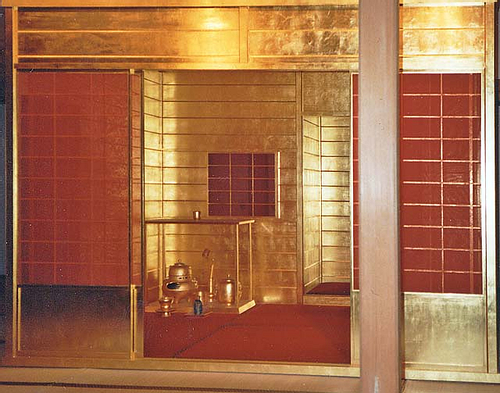
Besides helping the ceramics industry, Hideyoshi also helped develop the definitive form of the Japanese Tea Ceremony. This was done through his appointment of Sen no Rikyu (1522-1591 CE) as official tea master, and he would establish the tone and setting for the ceremony which was followed thereafter. Unfortunately for Rikyu, he fell out of favour with Hideyoshi for unknown reasons and was obliged to commit suicide. Hideyoshi himself had two teahouses for the ceremony which perhaps illustrate the complexity of the man - one was a traditional rustic house of plain materials and the other a gilded monument to bling and bad taste within Fushimi castle.
Death
Hideyoshi died of natural causes on 18 September 1598 CE but with no viable heir to his position as his son was but 5 years old at the time. Before his son had been born, Hideyoshi had selected his nephew, Hidetsugu, as his official heir, but on the news of his son's birth, the nephew was cast aside. As a symptom perhaps of the aged leader's growing paranoia that rivals were conspiring against him, Hidetsugu was compelled to commit ritual suicide and his wife, three young children, and his retainers were all executed.
Hideyoshi arranged for five senior ministers (tairo) to share the role of regent for his young son, but in the end, these men only fought amongst themselves for supremacy. Instead, the new supremo of Japan would be Tokugawa Ieyasu (r. 1603-1605 CE) who won the Battle of Skeigahara against those generals who supported Hideyoshi's son. Ieyasu thus established the Tokugawa Shogunate which finally saw the complete unification of Japan and which then enjoyed some 250 years of peace. As the old Japanese saying goes, "Nobunaga mixed the cake, Hideyoshi baked it, and Ieyasu ate it" (Beasley, 117).
This content was made possible with generous support from the Great Britain Sasakawa Foundation.
